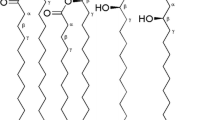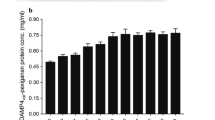Abstract
Lipid-1a-phosphatase LpxE cleaves the phosphate group in the first position of lipid A of lipopolysaccharide in Gram-negative bacteria, which reduces toxicity and reactogenicity of bacterial endotoxin while maintaining its immunogenicity. Treatment with these enzymes in preparations of recombinant proteins obtained in bacterial producers, for example, in E. coli, may find application in the purification techniques of various pharmaceutical substances, primarily various protein components of vaccines. This work is devoted to the creation of an efficient method for obtaining an F. tularensis LpxE soluble protein in a heterologous expression system based on E. coli. Optimization of the bacterial production of LpxE enzyme is achieved by creating a SUMO-LpxE chimeric protein in which the SUMO polypeptide acts as a folding catalyst and an affinity target carrier for purifying the expression product. An additional increase in the level of synthesis of LpxE and reduction of its toxicity for a bacterial strain is achieved against the background of superproduction of bacterial periplasmic chaperones encoded by an auxiliary low copy plasmid. Subsequent chromatographic purification of the target recombinant protein involves the use of affinity metal chelate chromatography and a SUMO protease cleavage step of the SUMO peptide carrying the His6 N-terminal peptide with the reduction of natural primary structure of the enzyme. The developed method makes it possible to obtain a highly purified active enzyme LpxE F. tularensis with a yield of 0.26 g/L of bacterial culture without fermentation.
Similar content being viewed by others
References
Williamson, E.D. and Oyston, P.C., Protecting against plague: Towards a next–generation vaccine, Clin. Exp. Immunol., 2013, vol. 172, no. 1, pp. 1–8.
Pichichero, M.E., Protein carriers of conjugate vaccines: Characteristics, development, and clinical trials, Hum. Vaccines Immunother., 2013, vol. 9, no. 12, pp. 2505–2523.
Delany, I., Rappuoli, R., and Seib, K.L., Vaccines, reverse vaccinology, and bacterial pathogenesis, Cold Spring Harbor Perspect. Med., 2013, vol. 3, no. 5, p. a012476.
Rosano, G.L. and Ceccarelli, E.A., Recombinant protein expression in Escherichia coli: Advances and challenges, Front. Microbiol., 2014, vol. 5, p. 172.
Structural Genomics Consortium; China Structural Genomics Consortium; Northeast Structural Genomics Consortium. Protein production and purification, Nat. Methods, 2008, vol. 5, no. 2, pp. 135–146.
Schwarz, H., Schmittner, M., Duschl, A., and Horejs–Hoeck, J., Residual endotoxin contaminations in recombinant proteins are sufficient to activate human CD1c+ dendritic cells, PLoS One, 2014, vol. 9, no. 12, p. e113840.
Baker, P.J., Hraba, T., Taylor, C.E., Myers, K.R., Takayama, K., Qureshi, N., et al., Structural features that influence the ability of lipid A and its analogs to abolish expression of suppressor T cell activity, Infect. Immun., 1992, vol. 60, no. 7, pp. 2694–2701.
Lu, Y.C., Yeh, W.C., and Ohashi, P.S., LPS/TLR4 signal transduction pathway, Cytokine, 2008, vol. 42, no. 2, pp. 145–151.
Moingeon, P., Haensler, J., and Lindberg, A., Towards the rational design of Th1 adjuvants, Vaccine, 2001, vol. 19, no. 31, pp. 4363–4372.
Wilson, M.J., Haggart, C.L., Gallagher, S.P., and Walsh, D., Removal of tightly bound endotoxin from biological products, J. Biotechnol., 2001, vol. 88, no. 1, pp. 67–75.
Dudley, A., McKinstry, W., Thomas, D., Best, J., and Jenkins, A., Removal of endotoxin by reverse phase HPLC abolishes anti–endothelial cell activity of bacterially expressed plasminogen kringle 5, Biotechniques, 2003, vol. 35, no. 4, pp. 724–726.
Habich, C., Kempe, K., van der Zee, R., Rümenapf, R., Akiyama, H., Kolb, H., and Burkart, V., Heat shock protein 60: Specific binding of lipopolysaccharide, J. Immunol., 2005, vol. 174, no. 3, pp. 1298–1305.
Magalhães, P.O., Lopes, A.M., Mazzola, P.G., Rangel–Yagui, C., Penna, T.C., and Pessoa, A., Jr., Methods of endotoxin removal from biological preparations: A review, J. Pharm. Pharm. Sci., 2007, vol. 10, no. 3, pp. 388–404.
Wakelin, S.J., Sabroe, I., Gregory, C.D., Poxton, I.R., Forsythe, J.L., Garden, O.J., and Howie, S.E., “Dirty little secrets”–endotoxin contamination of recombinant proteins, Immunol. Lett., 2006, vol. 106, no. 1, pp. 1–7.
Karbarz, M.J., Kalb, S.R., Cotter, R.J., and Raetz, C.R., Expression cloning and biochemical characterization of a Rhizobium leguminosarum lipid A 1–phosphatase, J. Biol. Chem., 2003, vol. 278, no. 41, pp. 39269–39279.
Wang, X., Karbarz, M.J., McGrath, S.C., Cotter, R.J., and Raetz, C.R., MsbA transporter–dependent lipid A 1 dephosphorylation on the periplasmic surface of the inner membrane: Topography of Francisella novicida LpxE expressed in Escherichia coli, J. Biol. Chem., 2004, vol. 279, no. 47, pp. 49470–49478.
Tran, A.X., Karbarz, M.J., Wang, X., Raetz, C.R.H., McGrath, S.C., Cotter, R.J., et al., Periplasmic cleavage and modification of the 1–phosphate group of Helicobacter pylori lipid A, J. Biol. Chem., 2004, vol. 279, no. 53, pp. 55780–55791.
Park, B.S., Song, D.H., Kim, H.M., Choi, B.S., Lee, H., and Lee, J.O., The structural basis of lipopolysaccharide recognition by the TLR4–MD–2 complex, Nature, 2009, vol. 458, no. 7242, pp. 1191–1195.
Gaekwad, J., Zhang, Y., Zhang, W., Reeves, J., Wolfert, M.A., and Boons, G.J., Differential induction of innate immune responses by synthetic lipid a derivatives, J. Biol. Chem., 2010, vol. 285, no. 38, pp. 29375–29386.
Mata–Haro, V., Cekic, C., Martin, M., Chilton, P.M., Casella, C.R., and Mitchell, T.C., The vaccine adjuvant monophosphoryl lipid A as a TRIF–biased agonist of TLR4, Science, 2007, vol. 316, no. 5831, pp. 1628–1632.
Qureshi, N., Takayama, K., and Ribi, E., Purification and structural determination of nontoxic lipid A obtained from the lipopolysaccharide of Salmonella typhimurium, J. Biol. Chem., 1982, vol. 257, no. 19, pp. 11808–11815.
Ulrich, J.T. and Myers, K.R., Monophosphoryl lipid A as an adjuvant. Past experiences and new directions, Pharm. Biotechnol., 1995, vol. 6, pp. 495–524.
Persing, D.H., Coler, R.N., Lacy, M.J., Johnson, D.A., Baldridge, J.R., Hershberg, R.M., and Reed, S.G., Taking toll: Lipid A mimetics as adjuvants and immunomodulators, Trends Microbiol., 2002, vol. 10, no. 10, Suppl., pp. S32–S37.
Kundi, M., New hepatitis B vaccine formulated with an improved adjuvant system, Expert Rev. Vaccines, 2007, vol. 6, no. 2, pp. 133–140.
Schlapschy, M., Grimm, S., and Skerra, A., A system for concomitant overexpression of four periplasmic folding catalysts to improve secretory protein production in Escherichia coli, Protein Eng., Des. Sel., 2006, vol. 19, no. 8, pp. 385–390.
Studier, F.W. and Moffatt, B.A., Use of bacteriophage T7 RNA polymerase to direct selective high–level expression of cloned genes, J. Mol. Biol., 1986, vol. 189, no. 1, pp. 113–130.
Satakarni, M. and Curtis, R., Production of recombinant peptides as fusions with SUMO, Protein Expression Purif., 2011, vol. 78, no. 2, pp. 113–119.
Huang, X.C., Quesada, M.A., and Mathies, R.A., DNA sequencing using capillary array electrophoresis, Anal. Chem., 1992, vol. 64, no. 18, pp. 2149–2154.
Lamberg, A., Nieminen, S., Qiao, M., and Savilahti, H., Efficient insertion mutagenesis strategy for bacterial genomes involving electroporation of in vitro–assembled DNA transposition complexes of bacteriophage mu, Appl. Environ. Microbiol., 2002, vol. 68, no. 2, pp. 705–712.
Yuannan Xia and Peng Luan, Int. Patent WO2003100022, 2003.
Karbarz, M.J., Six, D.A., and Raetz, C.R., Purification and characterization of the lipid A 1–phosphatase LpxE of Rhizobium leguminosarum, J. Biol. Chem., 2009, vol. 284, no. 1, pp. 414–425.
Sørensen, H.P. and Mortensen, K.K., Soluble expression of recombinant proteins in the cytoplasm of Escherichia coli, Microb. Cell Fact., 2005, vol. 4, no. 1, p. 1.
Dwyer, R.S., Malinverni, J.C., Boyd, D., Beckwith, J., and Silhavy, T.J., Folding lacZ in the periplasm of Escherichia coli, J. Bacteriol., 2014, vol. 196, no. 18, pp. 3343–3350.
Pan, K.–L., Hsiao, H.–C., Weng, C.–L., Wu, M.–S., and Chou, C.P., Roles of DegP in prevention of protein misfolding in the periplasm upon overexpression of penicillin acylase in Escherichia coli, J. Bacteriol., 2003, vol. 185, no. 10, pp. 3020–3030.
Selzer, G., Som, T., Itoh, T., and Tomizawa, J.–I., The origin of replication of plasmid p15A and comparative studies on the nucleotide sequences around the origin of related plasmids, Cell, 1983, vol. 32, no. 1, pp. 119–129.
Ma, B., Reynolds, C.M., and Raetz, C.R., Periplasmic orientation of nascent lipid A in the inner membrane of an Escherichia coli LptA mutant, Proc. Natl. Acad. Sci. U. S. A., 2008, vol. 105, no. 37, pp. 13823–13828.
Author information
Authors and Affiliations
Corresponding author
Additional information
Original Russian Text © A.V. Kozyr, L.A. Lisitskaya, A.K. Ryabko, N.A. Zeninskaya, M.A. Marin, O.N. Krasavtseva, I.G. Shemyakin, A.V. Kolesnikov, 2018, published in Molekulyarnaya Genetika, Mikrobiologiya i Virusologiya, 2018, No. 1, pp. 29–36.
About this article
Cite this article
Kozyr, A.V., Lisitskaya, L.A., Ryabko, A.K. et al. Shaperone-Dependent Optimization of Expression in E. coli and Purification of Soluble Recombinant Lipid A Phosphatase LpxE from Francisella tularensis. Mol. Genet. Microbiol. Virol. 33, 34–43 (2018). https://doi.org/10.3103/S089141681801007X
Received:
Accepted:
Published:
Issue Date:
DOI: https://doi.org/10.3103/S089141681801007X




